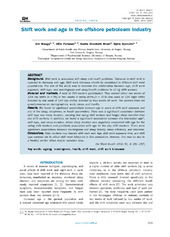| dc.contributor.author | Waage, Siri | en_US |
| dc.contributor.author | Pallesen, Ståle | en_US |
| dc.contributor.author | Moen, Bente Elisabeth | en_US |
| dc.contributor.author | Bjorvatn, Bjørn | en_US |
| dc.date.accessioned | 2016-08-05T06:37:36Z | |
| dc.date.available | 2016-08-05T06:37:36Z | |
| dc.date.issued | 2010 | |
| dc.identifier | https://journals.viamedica.pl/international_maritime_health/article/view/26214 | |
| dc.Published | International Maritime Health 2010, 61(4):251-257 | eng |
| dc.identifier.issn | 2081-3252 | |
| dc.identifier.uri | https://hdl.handle.net/1956/12451 | |
| dc.description.abstract | Background. Shift work is associated with sleep and health problems. Tolerance to shift work is reported to decrease with age. Shift work tolerance should be considered in different shift work populations. The aim of the study was to examine the relationship between age, shift work exposure, shift type, and morningness and sleep/health problems in oil rig shift workers. Material and methods. A total of 199 workers participated. They worked either two weeks of 12-h day shifts (n = 96) or two weeks of swing shifts (n = 103) (one week of 12-h night shifts followed by one week of 12-h day shifts), followed by four weeks off work. The workers filled out questionnaires on demographics, work, sleep, and health. Results. We found no significant associations between age or years of shift work exposure and any of the sleep, sleepiness, or health parameters. There was a significant association between shift type and sleep duration, showing that swing shift workers had longer sleep duration than day shift workers. In addition, we found a significant association between the interaction age*, shift type, and sleep duration, where sleep duration was negatively associated with age for the swing shift workers and positively associated with age for the day shift workers. There were significant associations between morningness and sleep latency, sleep efficiency, and insomnia. Conclusions. Older workers may tolerate shift work well. Age, shift work exposure time, and shift type seemed not to affect shift work tolerance in this population. However, this may be due to a healthy worker effect and/or selection bias. | en_US |
| dc.language.iso | eng | eng |
| dc.publisher | Via Medica | eng |
| dc.relation.uri | http://www.google.no/url?sa=t&source=web&cd=1&ved=0CBcQFjAA&url=http%3A%2F%2Fwww.intmarhealth.pl%2Fdarmowy_pdf.phtml%3Findeks%3D9%26indeks_art%3D152%26VSID%3D1a7bf9b3bae1df6fa2b37123a99a3d53&rct=j&q=% | |
| dc.rights | Attribution CC BY-NC-ND | eng |
| dc.rights.uri | http://creativecommons.org/licenses/by-nc-nd/4.0/ | eng |
| dc.subject | ageing | eng |
| dc.subject | morningness | eng |
| dc.subject | health | eng |
| dc.subject | shift work | eng |
| dc.subject | shift work tolerance | eng |
| dc.title | Shift work and age in the offshore petroleum industry | en_US |
| dc.type | Peer reviewed | |
| dc.type | Journal article | |
| dc.date.updated | 2016-04-08T08:16:30Z | |
| dc.description.version | publishedVersion | en_US |
| dc.rights.holder | Copyright 2010 Via Medica | |
| dc.identifier.cristin | 539509 | |
| dc.subject.nsi | VDP::Medisinske fag: 700::Helsefag: 800::Yrkesmedisin: 809 | |
| dc.subject.nsi | VDP::Midical sciences: 700::Health sciences: 800::Occupational health: 809 | |

